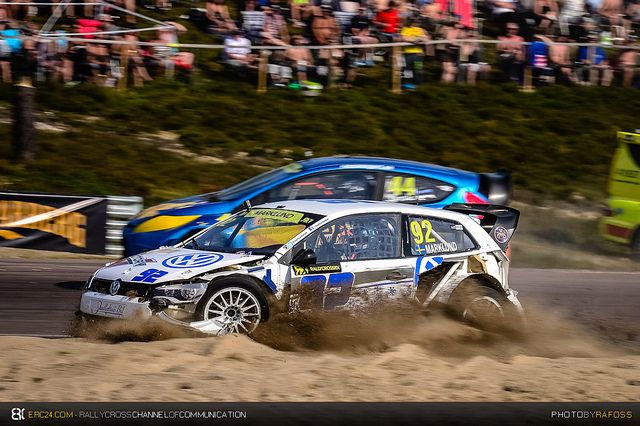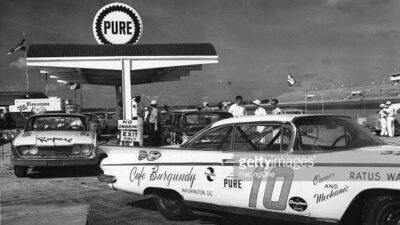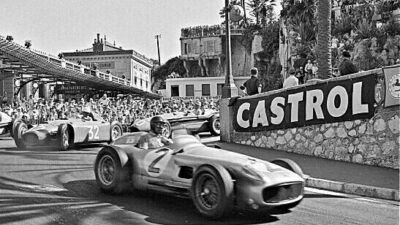Rallycross stands out in the motorsport world by combining the best elements of circuit racing and rally driving into short, intense competitions. Unlike traditional racing that takes place on either paved tracks or dirt roads, rallycross uses mixed-surface circuits that challenge drivers to master both asphalt and gravel in a single race.

What makes rallycross truly unique is its sprint-style format where multiple cars race simultaneously on compact tracks that feature jumps, tight corners, and surface changes that demand split-second adaptability from drivers. This creates an explosive spectacle where anything can happen in just a few minutes of racing.
The sport offers accessibility that many other forms of motorsport cannot match. While professional rallycross features specialized equipment and dedicated rally cars, grassroots events welcome a wide variety of vehicles, making it possible for everyday enthusiasts to experience the thrill of mixed-surface racing without massive financial investment.
Key Takeaways
- Rallycross combines paved and dirt surfaces in short, action-packed races with multiple cars competing simultaneously
- The sport requires drivers to master unique skills like handling surface transitions, jumps, and close-quarters racing
- Rallycross offers both professional competition and accessible grassroots events for enthusiasts at all levels
Defining Rallycross and Its Unique Appeal
Rallycross stands as a form of sprint style motorsport held on a mixed-surface racing circuit that began in the 1960s as a television-friendly racing format. This motorsport combines paved and unpaved surfaces with simultaneous multi-car starts, creating intense short-duration races that offer both drivers and spectators an electrifying experience.
Blending On-Road and Off-Road Racing
Rallycross creates its distinctive character through mixed-surface tracks that combine both paved roads and dirt or gravel sections. Unlike traditional circuit racing on smooth asphalt, rallycross deliberately mixes different surfaces.
Track Surface Combinations:
- Asphalt sections for high-speed cornering
- Gravel areas requiring car control skills
- Dirt portions that create sliding conditions
- Grass sections adding unpredictability
Races typically run up to 8 cars starting simultaneously on short circuits. The mixed surfaces demand different driving techniques within the same race.
Drivers must adapt their approach constantly. They use precision on tarmac sections and controlled sliding on loose surfaces.
The joker lap adds tactical complexity to many rallycross series. This extended circuit section allows drivers to separate from competitors or rejoin the pack strategically.
Origins and Evolution
Television producer Robert Reed created rallycross in 1967 for ABC Weekend TV. His vision combined “the thrills of autocross with the ordeals of rallying, reducing seven days and 3,000 miles to seven minutes and one mile.”
The first rallycross event took place at Lydden Circuit in Kent on February 4, 1967. The natural amphitheater setting with varying gradients allowed four cameras to maintain visibility of all cars.
Key Early Developments:
- 1967: First televised rallycross at Lydden Circuit
- 1968: Tony Chappell won the first championship
- 1969: Sport expanded to the Netherlands and Australia
- 1970s: BBC adopted the format for Grandstand programming
The motorsport evolved from a television spectacle into a global participation sport. The FIA established the World Rallycross Championship in 2014.
Modern rallycross features multiple vehicle classes from grassroots to professional levels. Electric categories were introduced in 2021, showing the sport’s continued evolution.
Global Popularity
Rallycross gained international recognition through its television-friendly format. The sport attracts nearly ten million British viewers during major events in its early years.
Current Global Presence:
- Europe: FIA World and European Championships
- United States: Various regional series and events
- Australia: Historical presence with modern revival attempts
The FIA World Rallycross Championship features 12 global events for the Supercar category. Professional series travel across continents including events in Portugal, Germany, and the United States.
Grassroots participation remains strong worldwide. The SCCA RallyCross program in America offers accessible motorsport for drivers of any skill level in almost any car.
The sport’s appeal comes from its accessibility and excitement. Short race durations create intense competition without requiring extensive preparation time between heats.
Multiple manufacturers support factory teams including Ford, Hyundai, and Subaru. This manufacturer involvement demonstrates rallycross’s commercial viability in modern motorsports.
Distinctive Race Formats
Rallycross uses a multi-stage competition system with qualifying heats followed by knockout rounds, plus mandatory joker laps that add tactical complexity. Most races last only 4-6 laps, creating intense wheel-to-wheel battles.
Heats and Finals Structure
Rallycross events use a heat-based format that differs from traditional circuit racing. Drivers first compete in qualifying heats with 4-6 cars per race.
Points are awarded based on finishing position in each heat. The best performers advance to semi-finals, while others face elimination.
Heat Structure:
- Qualifying Heats: 3-4 rounds per driver
- Semi-Finals: Top qualifiers compete
- Finals: Best 6 drivers race for victory
Semi-finals determine the final grid positions. Only the fastest drivers from semi-finals advance to the main event.
This knockout format creates pressure from the first lap. Drivers cannot afford poor starts or mistakes in any heat.
Joker Lap Explained
The joker lap adds a unique strategic element to rallycross. Each driver must take an alternate, longer route once during their race.
This detour typically adds 2-3 seconds to lap time. Drivers choose when to take it based on track position and competitors.
Joker Lap Strategy:
- Early: Avoid traffic but lose track position
- Late: Risk getting blocked by other cars
- Mid-race: Balance position and timing
The joker route often features different surface conditions. Some have tighter turns while others include jumps or longer straight sections.
Timing the joker lap correctly can make the difference between winning and losing. Smart drivers use it to overtake or defend position.
Short, Intense Competitions
Rallycross races are deliberately short, lasting just 4-6 laps per heat. This creates non-stop action from start to finish.
Each heat runs approximately 3-4 minutes. There is no time for drivers to settle into rhythm or recover from mistakes.
Race Characteristics:
- Duration: 3-4 minutes per heat
- Laps: 4-6 per race
- Cars: Up to 6 simultaneous competitors
The short format keeps spectators engaged throughout. Every corner and overtaking move matters for the final result.
Multiple cars racing together creates constant battles. Drivers must make quick decisions while managing different track surfaces at high speed.
Challenging Track Features
Rallycross tracks combine multiple surface types with technical obstacles that test driver skill and vehicle performance. These features create intense racing conditions where drivers must adapt quickly to changing grip levels and navigate complex course layouts.
Mixed Surfaces
Rallycross tracks deliberately mix different surfaces including asphalt, dirt, gravel, and grass sections. This combination forces drivers to constantly adjust their driving technique within a single lap.
The transition between surfaces creates the biggest challenge. A car traveling at high speed on asphalt must quickly adapt when hitting a loose gravel section.
Surface Types and Characteristics:
- Asphalt: High grip, predictable handling, allows maximum speed
- Gravel: Loose surface, requires controlled slides, reduces traction
- Dirt: Variable grip depending on moisture, creates dust clouds
- Grass: Low grip, slippery when wet, unpredictable surface
Tire choice becomes critical with mixed surfaces. Drivers must select compounds that work across all surface types rather than optimizing for one specific condition.
Weather conditions dramatically affect surface behavior. Rain turns dirt sections into mud while making grass areas extremely slippery.
Jumps and Obstacles
Rally cross courses feature elevation changes and jumps that add spectacular high-speed action to races. These obstacles require precise speed control and landing technique.
Small jumps launch cars briefly airborne. Drivers must maintain control during flight and prepare for impact on landing.
Jump Navigation Techniques:
- Pre-jump speed adjustment prevents overshooting landing zones
- Suspension setup affects how cars handle airborne moments
- Throttle control during landing maintains traction
- Weight transfer management prevents nose-heavy or tail-heavy landings
Courses include various challenging features such as elevation changes that test vehicle dynamics. Sharp crests can unsettle cars and reduce tire contact with the ground.
Banking and off-camber sections add complexity. These features change how cars behave through turns and require different racing lines.
Hairpin Turns
Sharp hairpin turns force drivers to drastically reduce speed and execute precise cornering techniques. These tight corners often become overtaking opportunities during wheel-to-wheel racing.
Entry speed determines success through hairpins. Too fast results in sliding wide while too slow allows competitors to gain position.
Hairpin Racing Dynamics:
| Technique | Purpose | Risk |
|---|---|---|
| Late braking | Maintain position | Potential overshoot |
| Early apex | Quick exit speed | Vulnerable to inside pass |
| Defensive line | Block overtaking | Slower overall time |
Multiple cars approaching hairpins create intense racing situations. The outside line sometimes offers better exit speed despite longer distance.
Surface changes within hairpin turns add extra difficulty. A turn might begin on asphalt but exit onto gravel, requiring different techniques for each section.
Hairpins often connect different track sections. They serve as transition points between high-speed straights and technical portions of the course.
Technical Demands and Vehicle Specialization
Rallycross racing pushes vehicles to extreme limits across mixed surfaces, requiring specialized builds that differ significantly from standard racing cars. Purpose-built Supercars dominate the top tier with engines up to 3.5 liters, while modified production cars compete in touring categories.
Supercars and Touring Cars
Supercars represent the pinnacle of rallycross vehicle technology. These purpose-built machines feature powerful engines ranging from 2.0 to 3.5 liters with advanced aerodynamics.
Most Supercars use turbocharged four-cylinder engines producing over 600 horsepower. They accelerate from 0-60 mph in under 2 seconds.
Key Supercar specifications:
- All-wheel drive systems
- Sequential gearboxes
- Carbon fiber bodywork
- Advanced suspension systems
Touring Cars use production-based platforms with two-liter engine limits. These four-door vehicles maintain recognizable shapes from their street counterparts.
Super1600 cars occupy a middle ground with 1.6-liter engines. Kit Cars represent the entry level with similar displacement but two-door configurations.
Vehicle Setup for Rallycross
Rallycross vehicles require unique setups to handle both tarmac and dirt sections effectively. Suspension systems must absorb jumps while maintaining grip through tight corners.
Critical setup elements include:
- Adjustable dampers for surface changes
- Reinforced chassis and roll cages
- Specialized tires for mixed surfaces
- Enhanced cooling systems
RX2 cars feature mid-engine layouts behind the driver’s cabin, creating distinctive handling characteristics. This configuration improves weight distribution for better traction.
Ground clearance becomes crucial for navigating rough terrain. Teams adjust ride height based on track conditions and surface composition.
Aerodynamic packages balance downforce with reduced drag. Front splitters and rear wings help maintain stability at high speeds while allowing for airborne moments over jumps.
Driving Skills and Strategy
Rallycross drivers must master precise car control across mixed surfaces while making split-second tactical decisions that can determine race outcomes. Speed, skill, and strategy form the foundation of competitive rallycross performance.
Car Control and Adaptability
Drivers navigate courses that combine dirt, gravel, and tarmac sections within a single lap. This requires instant adaptation as grip levels change dramatically between surfaces.
Surface Transitions demand immediate steering and throttle adjustments. A driver exits a dirt corner and hits pavement at full speed. They must instantly reduce steering input to prevent oversteering.
Car control at high speeds separates skilled drivers from beginners. Lightning-fast reflexes and exceptional car control become essential when navigating tight corners at 60+ mph.
Key Control Skills:
- Throttle modulation for different surfaces
- Steering precision during surface changes
- Brake balance adjustment
- Weight transfer management
Drivers practice controlling slides and maintaining speed through corners. They learn to use controlled oversteer on loose surfaces while maintaining grip on tarmac sections. This adaptability proves crucial during races when track conditions change rapidly.
Tactical Decision-Making
Race strategy extends beyond pure speed. Drivers must choose when to attack competitors and when to protect their position.
The joker lap adds a strategic element unique to rallycross. Each driver must take this alternate, usually longer route once per race. Timing this decision affects track position and race outcomes.
Strategic planning and anticipation help drivers gain advantages over opponents. They study competitors’ patterns and plan overtaking moves several corners ahead.
Strategic Considerations:
- Joker lap timing
- Overtaking opportunities
- Tire preservation
- Risk assessment
Drivers analyze track conditions throughout practice sessions. They identify the fastest racing lines and potential passing zones. During races, they constantly evaluate whether aggressive moves will pay off or result in costly mistakes.
Split-second decisions determine race results. A driver might choose to dive inside at a corner or wait for a safer opportunity. These choices require balancing speed with calculated risk-taking.
Community and Grassroots Access
Rallycross stands out as one of the most welcoming forms of motorsport, with grassroots events accepting drivers of any skill level in nearly any vehicle. The sport’s volunteer-driven structure keeps costs low while creating tight-knit racing communities across the country.
Entry for Beginners
New drivers can participate in rallycross events without expensive modifications or specialized equipment. Most events welcome stock vehicles from sedans to SUVs.
Beginners typically need only a helmet and basic safety gear to start competing. Many regions offer loaner helmets for first-time participants.
SCCA rallycross divides competitors into classes based on vehicle type and modifications. This ensures fair competition regardless of budget or experience level.
Entry fees usually range from $30-60 per event. This makes rallycross significantly cheaper than track days or other motorsports.
Most events include driver meetings that explain course layout and safety procedures. Experienced drivers often mentor newcomers throughout the day.
Role of Volunteers
Rallycross events depend entirely on volunteer workers to function. Participants take turns working corners, timing, and course setup between their driving runs.
Corner workers watch for safety issues and reset cones knocked over by previous drivers. They communicate with race control using radios or hand signals.
Timing volunteers record lap times and manage scoring systems. Course designers create challenging layouts that test driver skill while maintaining safety.
The volunteer system creates strong community bonds among participants. Drivers help each other with car repairs and share driving techniques.
This cooperative approach keeps event costs low compared to professional motorsports. It also ensures that experienced members actively welcome and train newcomers.
Frequently Asked Questions
Rallycross circuits combine paved and dirt surfaces with strategic elements like joker laps that set the sport apart from traditional racing formats. The unique mix of production-based cars, weather challenges, and specialized scoring systems creates distinct competitive dynamics.
What are the defining characteristics of a rallycross circuit?
Rallycross tracks deliberately mix different surfaces, combining both paved roads and dirt or gravel sections. This creates a unique challenge that separates the sport from traditional circuit racing.
The courses are typically short and compact. They feature a combination of tarmac and loose surface sections that test driver adaptability.
Most rallycross venues use temporary circuits. Traffic cones build race courses on grass or dirt fields, which eliminates most hazards and barriers found in other motorsports.
The mixed surface design forces drivers to constantly adjust their driving technique. They must handle grip changes between asphalt and dirt within seconds of each other.
How does the race format of rallycross differ from traditional rally racing?
Traditional rally racing involves point-to-point stages run against the clock. Cars start at timed intervals and compete for the fastest overall time across multiple stages.
Rallycross features direct wheel-to-wheel competition instead. Multiple cars race simultaneously on the same short track, creating immediate competitive pressure.
The format typically includes qualifying rounds followed by elimination heats. Drivers compete in heats that determine the starting order for the final race.
Each race lasts only a few minutes compared to rally’s longer stages. This creates intense, sprint-style competition that demands immediate performance rather than endurance.
What types of cars compete in rallycross events, and how are they modified?
Almost any production-based car can compete in rallycross after passing safety inspection. The sport welcomes everything from daily drivers to purpose-built race cars.
Most makes and models can compete regardless of drivetrain. Front-wheel drive, rear-wheel drive, and all-wheel drive vehicles all have dedicated classes.
Professional rallycross features highly modified supercars with turbocharged engines. These purpose-built machines produce over 600 horsepower and include advanced aerodynamic packages.
Amateur levels often use lightly modified street cars. Basic safety equipment like roll bars may be preferred but aren’t always required for entry-level competition.
What is the strategic significance of the ‘joker lap’ in rallycross?
The joker lap represents a mandatory alternate route that adds strategic complexity to races. Each driver must take this longer path once during the race.
Timing the joker lap becomes crucial for competitive advantage. Drivers can use it defensively to maintain position or offensively to gain track position.
The joker section is typically longer than the main circuit. This creates a time penalty that drivers must factor into their race strategy.
Teams must decide when to take the joker based on traffic, track conditions, and competitor positions. Poor joker lap timing can cost valuable positions in the final results.
How does the unique scoring system in rallycross impact competition?
Rallycross uses a progressive elimination format rather than traditional championship points. Drivers advance through qualifying into semi-finals and finals based on heat results.
The system rewards consistency across multiple short races. A single poor qualifying run can eliminate drivers from advancing to later rounds.
Heat finishing positions determine starting order for subsequent races. This creates pressure to perform well in every session rather than just the final.
Championship points are awarded based on final finishing positions. However, reaching the final requires successful navigation of the entire elimination process.
What role does weather play in a typical rallycross event?
Weather dramatically affects the mixed surface characteristics of rallycross circuits. Rain transforms dirt sections into mud while making tarmac sections slippery.
Track conditions can change rapidly during an event. Early qualifying sessions may run on dry surfaces while later heats face completely different grip levels.
Surface conditions vary depending on venue and season, ranging from gravel and mud to snow. Each surface type demands different driving techniques and car setup approaches.
Teams cannot easily adjust car setup between short heats. Drivers must adapt their technique to changing conditions rather than relying on mechanical changes.










